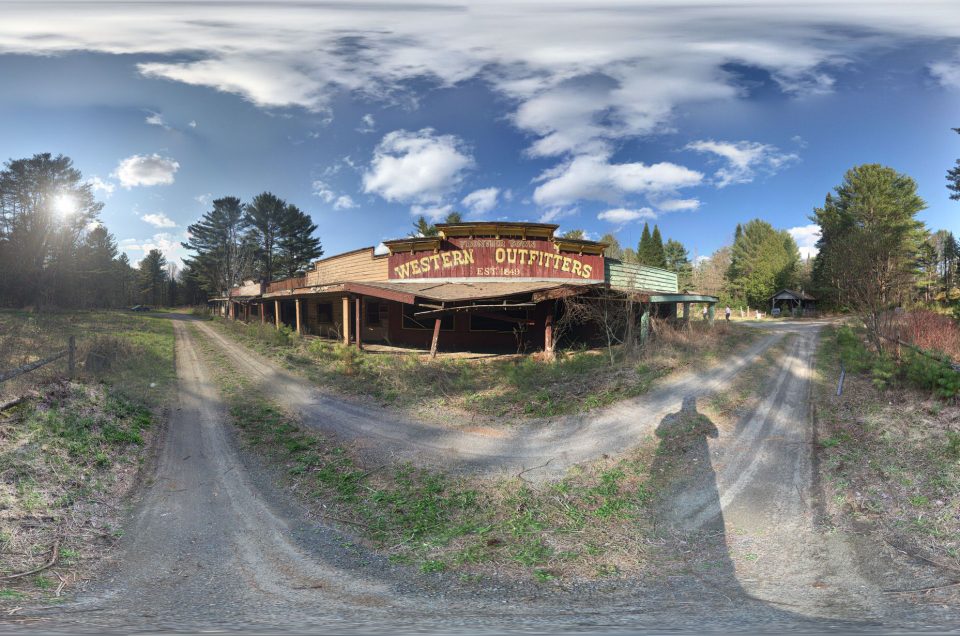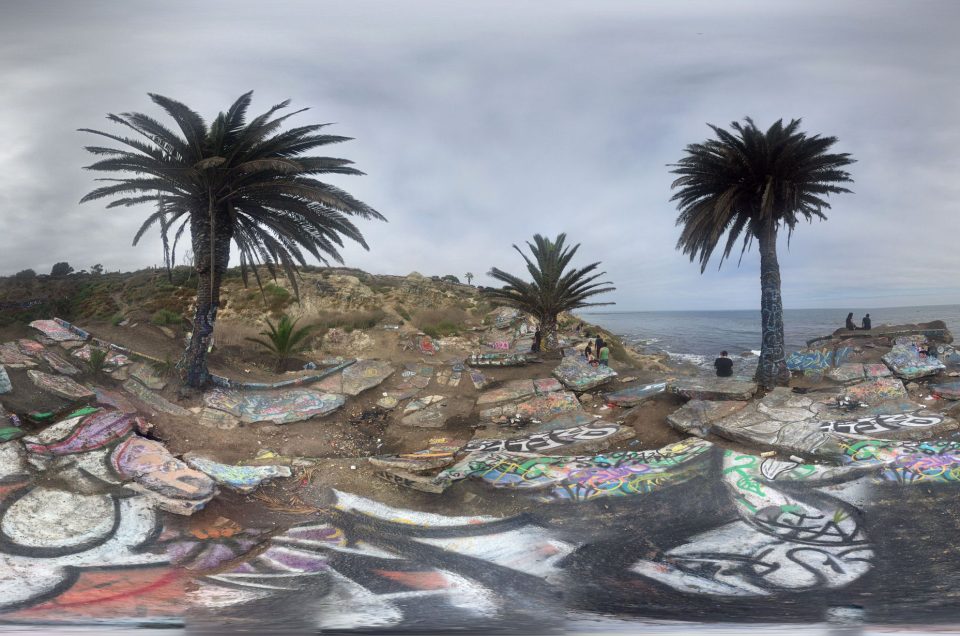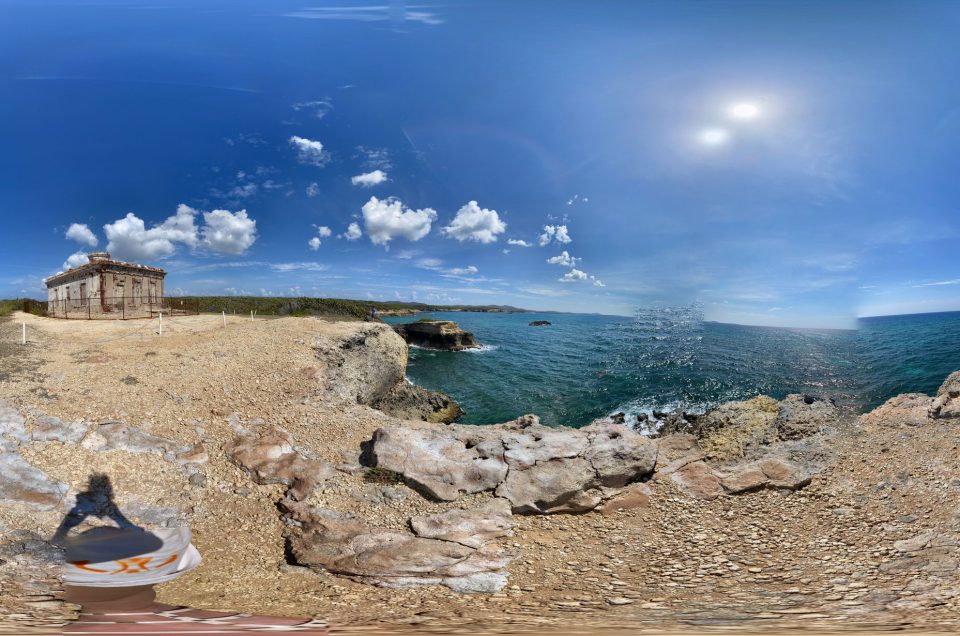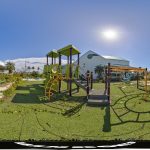Southwest Elementary School, Georgia – Abandoned School History & URBEX Guide
Take a look at Southwest Elementary School in rural Georgia, a former learning hub that now stands quietly waiting for curious urban explorers. Once filled with students, teachers, and daily routines, the school today offers a rare look at small-town education frozen in time. Its hallways, classrooms, and exterior details still tell a story of community life and change in the South.
Explore the Southwest Elementary School through the amazing self-guided interactive virtual tour below, featuring 14 detailed 360-degree panoramic images. This virtual walkthrough lets you study the layout, textures, and decay up close—perfect for URBEX enthusiasts who appreciate architecture, history, and abandoned places without giving away exact locations.
Click here to view it in fullscreen.
The abandoned Southwest Elementary School in Devereux (Hancock County), Georgia, is a fascinating spot for urban explorers. Once a lively place of learning, this rural school building now sits empty and overgrown. For adventurers and history buffs alike, it offers a glimpse into the past – from its segregated origins in 1959 through decades of teaching, to its closure in 2005. By combining colorful storytelling with documented facts, we’ll detail the full story of Southwest Elementary – its opening, the students and teachers who filled its halls, the reasons it was abandoned, and why today it’s a must-visit URBEX site in Georgia.
History: From Construction to Segregation
Southwest Elementary School was built in 1959 in the small Devereux community of Hancock County. According to local history, the new school was completed in December 1959 along with Hancock County Training (the county’s Black high school) as part of Georgia’s equalization school program. In its earliest days, Southwest Elementary began life as a segregated school for Black students. In April 1960 the Atlanta Daily World reported on Celestine G. Benson, a teacher at Southwest: “Mrs. Celestine G. Benson of the Southwest Elementary School, Devereux, Georgia, was chosen ‘Teacher of the Year.’ She is symbolic of the teaching profession…”. At that time, her husband A. M. Benson served as the school’s principal. This story highlights how Southwest Elementary was a point of pride in the African-American community of Devereux during segregation.
Throughout the 1960s and 1970s, public schools in Georgia were integrated. Southwest Elementary transitioned from serving only Black students to serving all children of the Devereux area. Despite these changes, the school remained small and locally focused. Even in later years, classes were tiny – one board member noted around 2007 that Southwest had only about 12 students per class. This intimate size meant the school had a tight-knit feel, with strong bonds between students and teachers. For nearly 46 years, Southwest Elementary quietly educated local children, a testament to its long-running role in the community.
Key Events in Southwest Elementary’s History:
-
1959: Southwest Elementary School is built in Devereux as a segregated (Black) elementary school.
-
1960: Teacher Celestine G. Benson is named Georgia’s “Teacher of the Year” while teaching at Southwest Elementary.
-
1970s: School desegregates and becomes part of the unified Hancock County school system.
-
2005: After lengthy debate, the Hancock County school board votes to close Southwest Elementary at the end of the year.
-
Post-2005: The building is left empty and overgrown – documented as “recently abandoned” by 2007.
Each of these milestones shaped the school’s story. In particular, the closure in 2005 marked the end of an era. For many years the school board had studied the costs of keeping Southwest open. Administrators noted that renovating or expanding the tiny school would be expensive. In 2005 the Board heard that updating Southwest’s aging facilities would cost over $1.7 million, paid entirely from local taxes, while annual operations cost about $408,000 per year. They saw that combining Southwest with the nearby M.E. Lewis Elementary (building more classrooms there) would save money. In May 2005 the Board announced that Southwest Elementary School would close at the end of the school year. Parents and teachers protested, noting how well students had done in those small classes. But ultimately, budget realities won out. A board member later explained candidly, “We had to close Southwest Elementary School because Southwest’s operation took $500,000 from our budget.”.
With the closure decision made, all Southwest students were transferred to Lewis Elementary (later renamed M.E. Lewis). By summer 2005, the building was vacated. No new purpose was found for the old school, so it was simply left to the elements. By 2007 explorers and photographers were calling it “recently abandoned”. Since then it has remained empty.
A Day in the Old School
During its heyday, Southwest Elementary would have looked like many mid-century rural schools. The brick building housed a handful of classrooms, a hallway or two, and perhaps a small gym or cafeteria (if any). Classrooms likely held kindergarten through fifth grade students from the surrounding community. In the 1950s and 60s, these rooms were filled with rows of wooden desks, chalkboards on the walls, and posters of multiplication tables. Recess probably took place on a dirt or grassy playground outside. In 1960, when Celestine Benson won her award, the students of Southwest were mostly Black children dressed in neatly pressed clothes, in the era before integration. Mrs. Benson and Mr. Benson (her husband, the principal) would have been pillars of that community school, organizing events like the annual Awards Day or a Black History program (one 1960 report mentions a February Black History event).
By the 1980s and 90s, Southwest Elementary was an integrated school serving the entire community of Devereux. Class sizes remained small – in fact, a board member years later remarked that the “best students” came from Southwest precisely because there were only about a dozen kids in each class. This tight student-teacher ratio meant very personalized attention. Students likely enjoyed a family atmosphere where everyone knew one another. Perhaps they had class pets or yearbooks (many Southern schools did). Clubs or sports were minimal; rural elementary schools often only had a playground. Still, a gymnasium or outdoor basketball court may have existed, since the Board later mentioned an athletic complex plan.
Classrooms would have seen dedicated teachers working hard. Along with Mrs. Benson, numerous other teachers passed through Southwest’s doors. Board minutes from the 2000s mention Title I plans and reading celebrations, showing that by the 2000s the school was part of federal programs to help underserved students. Yet life at Southwest was centered on the children and the limited resources of a rural district. Parents and a PTA helped when they could (the 2005 minutes talk about PTA involvement in events). The closing report even noted that Southwest had such involved parents they requested things like ice cream day at Awards Day.
In short, Southwest Elementary spent 46 years educating Devereux’s kids under one roof. It bridged eras – from segregation to integration – yet always remained a small town school. Its teachers and students made it more than just a building of bricks and classrooms; it was a center of community life and learning for generations.
Why It Was Abandoned
By the early 2000s, Hancock County was forced to confront declining enrollment and tight budgets. Like many rural areas, it could no longer afford multiple tiny schools. Southwest’s fate was decided by cost-benefit analysis: the district found the annual cost per student was much higher at Southwest than at larger schools. In Board meetings from 2005, officials laid out the math – simply upgrading or repairing the school would cost almost $2 million, and keeping it open used up $408,000 per year that could otherwise improve schools with more kids. Closing Southwest and adding classrooms to Lewis Elementary was seen as the fiscally responsible choice.
Some in the community disagreed. In an April 2005 meeting, an elder (Ms. Stewart) argued that closure was a mistake, saying “Southwest Elementary School was the worst thing the system could have done.” Others feared long bus rides for young children if their nearby school shut. But the Board stuck to its plan. At the May 2005 meeting, the board quietly confirmed: Southwest Elementary School will be closing at the end of the year. That meant June 2005 marked the last day of classes at Southwest. The remaining students were redistributed to other elementary schools. No replacement school was built in Devereux.
After the last bell rang, the building’s keys were turned in. Without a use, the old school began to collect dust. Grass grew in the yard; peeling paint and leaks crept in. By late 2005, Southwest Elementary stood empty. No plans were made to repurpose it (some rural districts turn old schools into storage or community centers, but Hancock did not here). Over the next few years, nature and vandals gradually reclaimed the property. By 2007, a local photo archive simply described the site as “recently abandoned”.
In summary: Southwest Elementary was closed due to its high operating costs versus enrollment. The tiny school had only a few dozen students in total, making it expensive per pupil. The decision to consolidate with a larger school in Lewis meant Southwest became an idle building. Once it was empty, it was abandoned, ending its role as an educational institution.
Exploring the Ghost School: Urbex in Georgia
Today, the old Southwest Elementary School is a magnet for urban explorers. Many call themselves URBEX enthusiasts, drawn to derelict buildings and their stories. As one of the abandoned schools in Georgia, this site appeals to anyone interested in decay, history, and adventure. By prowling its empty halls and overgrown grounds, visitors feel like time travelers stepping back into the school’s past.
For those curious about urban exploring in Georgia, Southwest Elementary offers a safe (and legal) thrill: it’s well-known online that the building is abandoned, and no one expects classes. In fact, NBA player Kammeon Holsey – a Sparta native – even held a community fun day at the empty Southwest Elementary in 2021. This event highlighted that, while the school is closed, it still belongs to the community’s story. Otherwise, most afternoons you’ll find only quiet. The building sits weathered by sun and rain, with vines wrapping around the columns.
When you visit Southwest Elementary today, here are some things you can look out for:
-
Vintage Classrooms: Many rooms still contain old school furniture. You might see rows of desks and chairs left where students last used them. Chalkboards often remain on the walls, sometimes still bearing faint chalk writing from years past. These relics make it feel like a classroom frozen in time – a favorite setting for Urbex photography.
-
Decaying Architecture: The building’s mid-century brick walls and tall classroom windows are crumbling. Peeling paint, rusting lockers, and collapsed ceilings are common. Look for historic details like original light fixtures, door locks, or faded bulletin boards. These elements show off the 1950s design and how nature is reclaiming the space.
-
Overgrown Grounds: Outside, the old playground or field (if still there) is likely carpeted with weeds and wild grass. The chain-link fence may have holes, and swings or concrete steps are cracked. Trees might even be growing through the pavement. This “ruin meets nature” scene is typical of abandoned schools and gives a hauntingly beautiful vibe.
-
Graffiti and Signs: Urbexers who visited before you may have left colorful graffiti on the walls – tags, messages, or even intricate artwork. Look for layers of paint and spray on bricks and lockers. A fun detail: sometimes explorers leave their own mark by carving or painting their name, so you might spot dates or usernames. (Always leave the place as you found it, though!)
-
Haunting Silence: One of the most surreal things is the quiet. Stand in the hall and listen – just the wind and maybe dripping water, instead of children’s chatter. It’s eerie and adventurous at once. Some explorers say you can almost feel the echo of footsteps from a school day long ago.
Safety Tip: Remember that this is an unsafe structure. Be very careful of broken glass, nails, mold, or weak floors. Always go with friends, bring a flashlight, and be mindful of trespassing laws. (Note: As of now, there are no official “no trespassing” notices visible, but that can change. Some explorers chose to stay in public areas or seek permission from the county if possible.)
Each visit to Southwest Elementary is a personal experience. Your own photos (like the author’s) might show dusty chalkboards, empty classrooms, or beams of light through shattered windows. Along with your camera, bring a sense of adventure and respect for the site. Many urban explorers treat these places as quiet memorials to the past – we walk lightly, take nothing but pictures, and leave nothing behind.
The Legacy of Southwest Elementary
Southwest Elementary School’s story is a microcosm of Georgia’s educational history. It began under segregation in 1959, thrived as a beloved community school for nearly half a century, and then closed because it became too costly to maintain. Yet its physical presence endures. By the 2020s, the old building stands as a weathered monument to the generations who passed through its doors.
For urban explorers and history lovers, the site is more than rubble – it’s a classroom of stories. In those empty rooms one can imagine the excitement of a “first day of school,” see the chalk lines from arithmetic lessons, or recall the names of teachers like Celestine Benson who dedicated their lives here. Every cracked window and stray desk is a piece of that history.
Visiting abandoned Southwest Elementary is like stepping into a time capsule. As you walk through silent halls and overgrown grounds, remember the voices that once filled this space. By exploring and sharing the tale of Southwest Elementary School, we keep its memory alive. Whether you’re a URBEX photographer searching for your next shot, an urban explorer tracing history, or just an adventurous soul, this abandoned school in Georgia offers a unique journey – a peaceful, poignant adventure through the past.
If you liked this blog post, you might be interested in learning about the Frontier Town Theme Park in New York, the Washington Building at Men’s State Prison in Georgia, or the Porcher House in Florida.
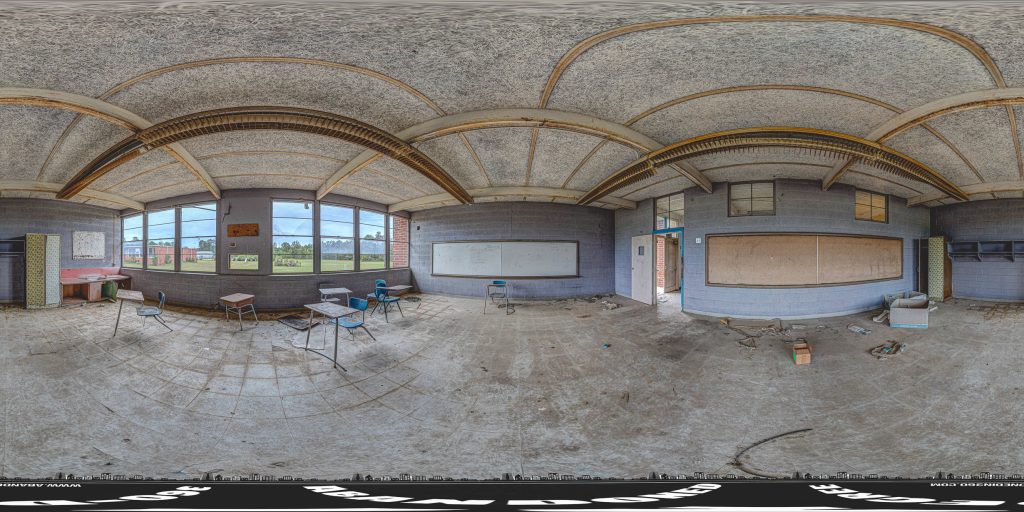
A 360-degree panoramic image inside one of the classrooms at the Southwest Elementary School in Georgia. Photo by the Abandoned in 360 URBEX Team.
Welcome to a world of exploration and intrigue at Abandoned in 360, where adventure awaits with our exclusive membership options. Dive into the mysteries of forgotten places with our Gold Membership, offering access to GPS coordinates to thousands of abandoned locations worldwide. For those seeking a deeper immersion, our Platinum Membership goes beyond the map, providing members with exclusive photos and captivating 3D virtual walkthroughs of these remarkable sites. Discover hidden histories and untold stories as we continually expand our map with new locations each month. Embark on your journey today and uncover the secrets of the past like never before. Join us and start exploring with Abandoned in 360.
Equipment used to capture the 360-degree panoramic images:
- Canon DSLR camera
- Canon 8-15mm fisheye
- Manfrotto tripod
- Custom rotating tripod head
Do you have 360-degree panoramic images captured in an abandoned location? Send your images to Abandonedin360@gmail.com. If you choose to go out and do some urban exploring in your town, here are some safety tips before you head out on your Urbex adventure. If you want to start shooting 360-degree panoramic images, you might want to look onto one-click 360-degree action cameras.
Click on a state below and explore the top abandoned places for urban exploring in that state.
